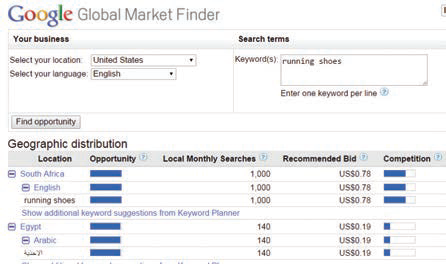Fundamentals of International SEO

Of all the various user acquisition channels available to today's enterprises - organic search remains one of the most attractive (as well as the most elusive).
As Google and its search engine counterparts continue to shape and reshape the digital search and discovery experience, brands are simultaneously looking for ways to increase their presence. Moving to support a more global or international audience provides just the sort of accessible initiative to make it happen.
Let's address a few of the key fundamentals of internationalizing a brand's search engine presence and some practical guidance for getting started.
Identify True International Opportunity
One of the more serious mistakes related to international SEO initiatives is failing to understand product or service demand in various countries (or among audiences). For example, there might be a great deal of interest in Sweden, but a disproportionately low amount in Siberia.
Brands can attempt to gain a greater understanding of the existing search volume in specific markets for their products or services by using a tool such as Google's own Global Market Finder, which lets SEOs compare opportunities from different locations (using Google search data and AdWords keyword bids) to determine opportunity and competition for translated keywords.

In the image above, for example, the geographic distribution from Google's Global Market Finder reveals that for the search term "running shoes," filtered for Africa, there are more local monthly searches in South Africa than Egypt (there is also greater competition and a higher recommended bid). If a U.S.-based, English-speaking business was considering expanding to Africa and had to choose where their investment might be most lucrative, South Africa might be the best option (as no Arabic translation services would be needed as they would if the country focus was Egypt).
Engage in Appropriate "Market" Targeting
Once there is some confidence that a genuine opportunity exists (wherein the potential traffic and conversions coming from additional countries or languages would outweigh the cost associated with developing an additional Web presence), it is necessary to determine whether it is optimal to 1) target the global audience speaking a specific language (regardless of location) or to 2) target a geographically focused audience speaking a specific language.
There's a big difference between the two (e.g. the French-Canadians in Montreal may have different digital expectations than speakers of the same language in French Guiana).
Let's take a closer look at which is most appropriate for various enterprise scenarios.
Language targeting is best used when the geographic location isn't necessarily important, or when it doesn't carry much weight when it comes to the goals of a website. Say, for example, that (based on research) the traffic arriving on a website is distributed over many countries that speak the same language. It would be wasteful (in terms of resources) to create a new website section for all the countries that spoke Spanish for example, but it would make sense to create a section dedicated exclusively to Spanish speakers (which could include multiple countries simultaneously).
Country targeting, on the other hand, is ideal in those instances when the location is a factor in the online business model but the language is irrelevant. If there is enough country- or region-specific search traffic (identified through the research) then building a site version targeting a specific country is the right option for the enterprise. If there is interest in establishing a footprint in new markets, but budgets for translation are limited or nonexistent, targeting those countries that use the same language as the business is the optimal approach as it enables the enterprise to scale their international initiative.
There are, of course, plenty of other considerations that must also be made.
Consider Website Structure and Code
Deciding on country or language targeting can seem difficult, but in reality, it's really only about whether one or many languages are spoken in a country, as well as the goals of the enterprise. Several technical issues, however, must also be addressed.
Website structure, for example, is routinely mentioned when international SEO is involved. There are many who tout the importance of choosing an appropriate site structure (directories, subdirectories, subdomains or even ccTLDs - which are already geo-targeted in the virtual eyes of Google - that are focused on a language or country/region) based on audience targeting and demographic characteristics. For others, it's not high on the priority list as they know that search engines tend not to put too much importance on the terminology used within naming conventions (although there is likely some weight assigned to it). Just remember that the aim should be to create an organized site-wide hierarchy that can be crawled and indexed by the search engines.
The best way to convey to search engines that a website (or its subdirectories or subdomains) is meant for a specific country (language targeting will be addressed next), however, is to indicate the geographic target to the search engines directly. Google, Bing and Yandex all offer this capability within their respective webmaster consoles, providing SEOs a means to directly specify which location/country the content is associated with. To make a page/site language specific, however, it is necessary to dive into the code and get (somewhat) technical.
When it is necessary to indicate to search engines that a document is language specific, consider using the following (for the HTPP header or the sitemap):

The code-based approach is used to signal to the search engines that pages may have substantially similar content with small differences that are important (e.g. perhaps including pricing data or shipping information) or where there are fully translated pages.
Using language annotations is a rather advanced SEO technique. It should, of course, go without saying that the most important aspect of internationalizing a digital presence of search is actually localizing the content - and that includes nearly every element; from the page title to the navigation, the copy, the images, the currency, phone numbers and more. SEOs should not just port over the same site - it's absolutely necessary to consider the linguistic and cultural differences, the demographics of an audience as well as the seasonality (see sidebar).
Measuring performance is another key stage in internationalizing SEO initiatives. Best practice is to track each of the language/country versions independently in separate Google Search Console and Bing Webmaster Tools site profiles (including for subdirectories, subdomains and ccTLDs) as well as separately within the analytics solution currently in use by the enterprise. Some popular SEO software solutions even offer rank tracking for specific countries.
Going International
Taking a digital presence international with SEO can be very beneficial to a brand's bottom line. By understanding demand, developing the right site structure and continually measuring performance, brands will find themselves on the fast track to international success.









